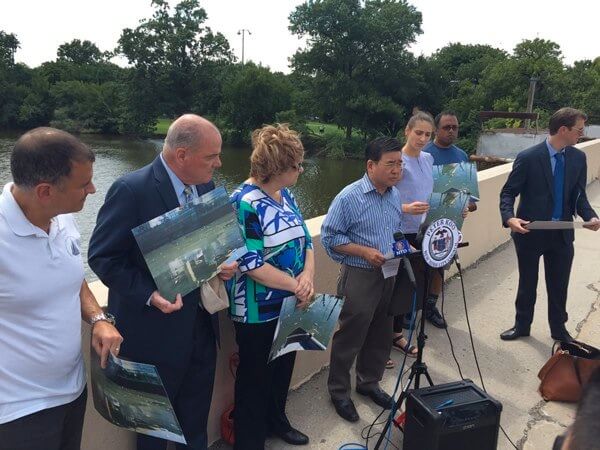By Gina Martinez
After thousands of dead fish were found in Flushing Creek, Councilman Peter Koo (D-Flushing) and local environmentalists are calling on the city to revise plans to chlorinate combined sewage overflows in Flushing’s waterways.
According to Koo, CSO’s occur when sewer capacity becomes overwhelmed by heavy rainfall, and storm water and untreated wastewater dump directly into the surrounding waterways. Earlier this year, the New York State Department of Environmental Conservation approved the New York City’s Department of Environmental Protection long-term control plans for Flushing Creek and Flushing Bay.
The plans were considered and approved separately, even though the two water bodies flow into each other. For Flushing Creek, plans call for the chlorination of CSO’s in order to disinfect the water. In Flushing Bay, plans call for the construction of a new tunnel.
In 2009, the city completed construction of a 43 million-gallon CSO tank in Flushing, but according to Koo, even this significant piece of infrastructure quickly becomes overburdened with heavy rains. Koo said the resulting outfalls create a noticeably rancid smell throughout communities. In November 2016, he asked the DEP to re-evaluate its plan for the Flushing Creek before moving forward with the Flushing Bay long-term control plan. Both plans were approved in March 2017.
Last week, staff at the environmental watchdog group Riverkeeper filmed massive outfalls flowing directly into the bay and creek, and discovered thousands of dead fish floating throughout the creek. Now, Koo and fellow advocates are calling on the city and state to withdraw and revise their plans to chlorinate in the Flushing Creek, and build new infrastructure to capture runoff so that it can be treated properly before being dumped into the natural environment.
“Today we are calling on the city and state to capture combined sewage overflows, don’t chlorinate!” Koo said. “If thousands of fish are dying today before chlorination even begins, imagine how much worse it will be once this misguided ‘solution’ is put into practice. Chlorine is what you put in your swimming pool to kill bacteria, not what you put into a tidal estuary full of precious marine life.”
In a statement, a DEP spokesman said that fish kills, such as the ones in Flushing Creek, are not uncommon, as predator fish trap groups of smaller fish in shallow waters until they have exhausted the available oxygen.
“Reckless charges about the cause of the fish kill that are not based on fact or science do not advance the cause of cleaner waterways,” the statement read.
The DEP said their scientists sampled the waters of Flushing Creek last Monday and there was sufficient oxygen to support marine life.
It said the heavy rains from the previous Monday were captured by the sewer overflow tank located in Flushing Meadows Corona Park.
The DEP said there were no combined sewer overflows and that the most likely cause of this fish kill is a natural phenomenon that occurs when a predatory fish, such as a bluefish, chases a school of bunker into a shallow water body and traps them until they have exhausted all of the oxygen supply in the water.
The DEP said this is not uncommon, there have been large bunker kills on Long Island, in Riverhead in 2015 and in Shinnecock Bay in 2016.
Reach Gina Martinez by e-mail at gmart
































